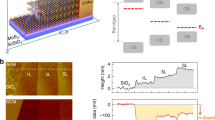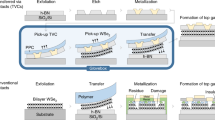Abstract
Hydrogen-resist lithography with the tip of a scanning tunnelling microscope can be used to fabricate atomic-scale dopant devices in silicon substrates and could potentially be used to build a dopant-based quantum computer. However, all devices fabricated so far have been based on the n-type dopant precursor phosphine. Here, we show that diborane can be used as a p-type dopant precursor, allowing p-type and bipolar dopant devices to be created. Characterization of diborane δ-layers reveals that similar mobilities and densities can be achieved as for phosphine, with sheet resistivities as low as 300 Ω □−1. Scanning tunnelling microscope imaging and transport measurements of a 5.5-nm-wide p-type dopant nanowire give an estimated upper bound of 2 nm for the lithographic resolution of the p-type dopant profiles. By combining our p-type doping approach with established phosphine-based n-type doping, we fabricate a 100-nm-wide p–n junction and show that its electrical behaviour is similar to that of an Esaki diode.
This is a preview of subscription content, access via your institution
Access options
Access Nature and 54 other Nature Portfolio journals
Get Nature+, our best-value online-access subscription
$29.99 / 30 days
cancel any time
Subscribe to this journal
Receive 12 digital issues and online access to articles
$119.00 per year
only $9.92 per issue
Buy this article
- Purchase on Springer Link
- Instant access to full article PDF
Prices may be subject to local taxes which are calculated during checkout





Similar content being viewed by others
Data availability
The data that support the findings of this study (STM images, raw measurement data, raw SIMS data) are available through Zenodo at https://doi.org/10.5281/zenodo.3881492. Further information is available from the corresponding author upon reasonable request.
References
Frank, D. et al. Device scaling limits of Si MOSFETs and their application dependencies. Proc. IEEE 89, 259–288 (2001).
Ho, J. et al. Controlled nanoscale doping of semiconductors via molecular monolayers. Nat. Mater. 7, 62–67 (2008).
Colombeau, B. et al. Advanced CMOS devices: challenges and implant solutions. Phys. Stat. Sol. A 211, 101–108 (2014).
Duffy, R. et al. Access resistance reduction in Ge nanowires and substrates based on non-destructive gas-source dopant in-diffusion. J. Mat. Chem. C 2, 9248–9257 (2014).
Muhonen, J. et al. Storing quantum information for 30 seconds in a nanoelectronic device. Nat. Nanotechnol. 9, 986–991 (2014).
Roche, B. et al. A two-atom electron pump. Nat. Commun. 4, 1581 (2013).
Schofield, S. et al. Atomically precise placement of single dopants in Si. Phys. Rev. Lett. 91, 136104 (2003).
Fuechsle, M. et al. A single-atom transistor. Nat. Nanotechnol. 7, 242–246 (2012).
Simmons, M. et al. Scanning probe microscopy for silicon device fabrication. Mol. Simul. 31, 505–514 (2005).
van der Heijden, J. et al. Probing the spin states of a single acceptor atom. Nano Lett. 14, 1492–1496 (2015).
Wang, Y., Shan, J. & Hamers, R. J. Combined scanning tunneling microscopy and infrared spectroscopy study of the interaction of diborane with Si(001). J. Vacuum Sci. Technol. B 14, 1038–1042 (1996).
Yu, L., Vitkavage, D. J. & Meyerson, B. Doping reaction of PH3 and B2H6 with Si(100). J. Appl. Phys. 59, 4032–4037 (1986).
Oura, K. et al. Hydrogen adsorption on Si(100)-2 × 1 surfaces studied by elastic recoil detection analysis. Phys. Rev. B 41, 1200–1203 (1990).
Dürr, M., Hu, Z., Biederman, A., Höfer, U. & Heinz, T. F. Real-space study of the pathway for dissociative adsorption of H2 on Si(001). Phys. Rev. Lett. 88, 046104 (2002).
Wang, Y. & Hamers, R. Boron-induced reconstructions of Si(001) investigated by scanning tunneling microscopy. J. Vacuum. Sci. Technol. A 13, 1431–1437 (1995).
Wilson, H. et al. Thermal dissociation and desorption of PH3 on Si(001): a reinterpretation of spectroscopic data. Phys. Rev. B 74, 195310 (2006).
Liu, Z., Zhang, Z. & Zhu, X. Atomic structures of boron-induced protrusion features on Si(100) surfaces. Phys. Rev. B 77, 035322 (2008).
Goh, K., Oberbeck, ls., Simmons, M., Hamilton, A. & Clark, R. Effect of encapsulation temperature on Si:P δ -doped layers. Appl. Phys. Lett. 85, 4953–4955 (2004).
Keizer, J., Koelling, S., Koenraad, P. & Simmons, M. Suppressing segregation in highly phosphorus doped silicon monolayers. ACS Nano 9, 12537–12541 (2015).
Luo, X., Zhang, S. & Wei, S.-H. Understanding ultrahigh doping: the case of boron in silicon. Phys. Rev. Lett. 90, 026103 (2003).
Bustarret, E. et al. Superconductivity in doped cubic silicon. Nature 444, 465–468 (2006).
Weir, B. et al. Electrical characterization of an ultrahigh concentration boron delta-doping layer. Appl. Phys. Lett. 65, 737–739 (1994).
Dai, P., Zhang, P. & Sarachik, M. Electrical conductivity of metallic Si:B near the metal-insulator transition. Phys. Rev. B 45, 3984–3994 (1992).
Pascher, N., Hennel, S., Mueller, S. & Fuhrer, A. Tunnel barrier design in donor nanostructures defined by hydrogen-resist lithography. N. J. Phys. 18, 083001 (2016).
Arrhenius, S. Über die Reaktionsgeschwindigkeit bei der Inversion von Rohrzucker durch Säuren. Z. Phys. Chem. 4, 226–248 (1889).
Ryu, H. et al. Atomistic modeling of metallic nanowires in silicon. Nanoscale 5, 8666–8674 (2013).
Oehme, M. et al. Si Esaki diodes with high peak to valley current ratios. Appl. Phys. Lett. 95, 242109–242111 (2009).
Fuhrer, A., Füchsle, M., Reusch, T., Weber, B. & Simmons, M. Atomic-scale, all epitaxial in-plane gated donor quantum dot in silicon. Nano Lett. 9, 707–710 (2009).
Acknowledgements
We acknowledge financial support from EU-FET grants SiAM 610637, PAMS 610446 and from the Swiss NCCR QSIT. We thank D. Widmer and G. Meyer for technical help with the STM system and software and N. Pascher, H. Schmid and J. Cole for discussions.
Author information
Authors and Affiliations
Contributions
A.F. designed the study and directed the project. S.A.K. and A.F. developed the diborane doping procedures, fabricated and measured the Hall bar devices, S.A.K., T.S. and A.F. developed the diborane lithography process, A.F. and T.S. designed, fabricated and measured the STM patterned devices. B.D., C.F. and T.S. performed the SIMS experiments and analysed the SIMS data. T.S., A.F. and S.A.K. analysed the device data and wrote the manuscript with contributions from all authors.
Corresponding author
Ethics declarations
Competing interests
The authors declare no competing interests.
Additional information
Publisher’s note Springer Nature remains neutral with regard to jurisdictional claims in published maps and institutional affiliations.
Rights and permissions
About this article
Cite this article
Škereň, T., Köster, S.A., Douhard, B. et al. Bipolar device fabrication using a scanning tunnelling microscope. Nat Electron 3, 524–530 (2020). https://doi.org/10.1038/s41928-020-0445-5
Received:
Accepted:
Published:
Issue Date:
DOI: https://doi.org/10.1038/s41928-020-0445-5
This article is cited by
-
EUV-induced hydrogen desorption as a step towards large-scale silicon quantum device patterning
Nature Communications (2024)
-
Uncovering anisotropic effects of electric high-moment dipoles on the tunneling current in \(\delta\)-layer tunnel junctions
Scientific Reports (2023)
-
A solid-state quantum microscope for wavefunction control of an atom-based quantum dot device in silicon
Nature Electronics (2023)
-
Conductivity and size quantization effects in semiconductor \(\delta\)-layer systems
Scientific Reports (2022)
-
Experimental realization of an extended Fermi-Hubbard model using a 2D lattice of dopant-based quantum dots
Nature Communications (2022)



